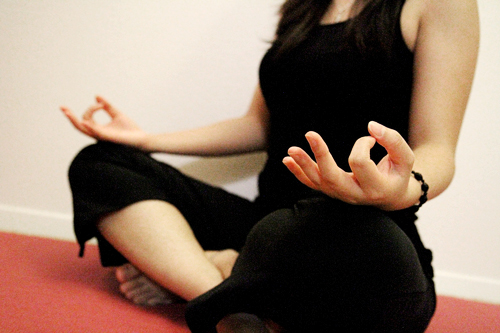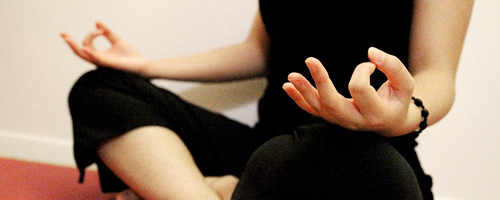Picture the muddled colors of your mental clutter diverging back into discernible hues. Imagine the cacophony of constant sensory overload assembling into a sense of melody. You are seated somewhere deep within yourself. From the quiet observatory of your focused state, you become acutely aware of your physical tensions, your mental strains.
A taste of enlightenment

Picture the muddled colors of your mental clutter diverging back into discernible hues. Imagine the cacophony of constant sensory overload assembling into a sense of melody.
You are seated somewhere deep within yourself. From the quiet observatory of your focused state, you become acutely aware of your physical tensions, your mental strains.
You are meditating.
“To really understand meditation, you have to do it,” said meditation teacher Lorna Knox. “It’s like trying to describe the taste of an orange.”
The Buddha savored every last drop of that orange. Sitting under the fig-bearing canopy of the Bodhi Tree, Siddhartha Gautama meditated for three days and three nights before attaining what Buddhists call enlightenment.
There are countless forms of meditation, but mindfulness meditation is a simple, easy-to-implement starting point for beginners wanting to give the practice a try. Branch out into different forms of meditation that capture your interest—every form has its own techniques, goals and health benefits. Take a class for an optimal guided experience.
MINDFULNESS MEDITATION 101
Adapted from Psychology Today
Mindfulness meditation involves paying careful, nonjudgmental attention to our present bodily and mental experience: It teaches us to be “unconditionally present.” The philosophy behind mindfulness comes from Buddhist tradition, which teaches that one source of suffering is the attempt to escape our direct experiences.
BODY, BREATH AND THOUGHTS
The body
Designate a quiet place for meditation. Find a comfortable seating arrangement that allows you to maintain a straight but not rigid posture.
Keep your eyes somewhat open and your gaze directed toward the floor.
Begin by sitting in this posture for a few minutes.
Your attention will wander. Take note of this, and gently bring your mind back into your environment.
The breath
Feel your breath as you inhale and exhale.
Pay light attention to this, but do not channel all of your focus toward your breath.
The rest of your attention will naturally fall on your body and environment.
Thoughts
You will notice a great number of thoughts overlapping. Just notice them as they float by.
Eventually, bring yourself back to your breath. Make a neutral label of the ‘thinking’ that just occurred.
Keep practicing for anywhere from 10 minutes to an hour.
Remember that the goal of mindfulness meditation
is not to become blank or to stop thinking,
but rather to be with ourselves as we already are.
Neuroscientists may have unearthed the mechanics behind that indescribable experience. Meditation, researchers say, literally changes the brain. And this plasticity is at the root of a number of health breakthroughs.
According to researchers at UCLA, people who regularly meditate for years show significant increases in cortical folding across many parts of the brain, leading to faster information processing in areas ranging from decision-making centers to regions responsible for emotional and mental health.
Too often, mental and physical health are compartmentalized. Ancient medicine, on the other hand, rejected this dualism, recognizing how entwined the two are. For millennia meditation has bridged the chasm between the mind and the body.
“We tend to have lives that are out of balance,” Knox said. “We’re either too physically active or not active enough. Too alone or too involved with people.”
Meditation seeks balance.
Meditating on ‘meditation’
What exactly is meditation? It isn’t an unusual question; the word has become a catch-all term.
Far from being a frivolous new trend, the kind of meditation popular today dates back thousands of years to prehistoric India.
The history of meditation is entwined with a variety of religious traditions, from Islam’s mystical Sufi tradition to Judaic Kabbalah to Hindu yoga. Meditation, it’s said, is a vessel toward the divine, an elevation of the soul.
But spirituality need not be invoked in modern-day meditation.
“So many things are being called meditation,” Knox said. Defining the many forms of meditation is further complicated by the fact that no two people will have the same experience.
Stripped to its essence, however, meditation is very simple. It is the focus and concentration of the mind into a deliberate awareness.
“Meditation brings us into the present moment,” said Julie Porter, an instructor in
Portland State’s School of Community Health, who teaches a capstone course called “Meditation for Global Healing.”
“Although unrelated thoughts may crop up in our minds, letting these thoughts float by without judgment is essential to meditation,” Porter added.
Noelle Savatta, a psychologist at the Center for Student Health and Counseling, finds that meditation can help reduce anxiety, depression and chronic pain. She recommends meditation, advising patients of its benefits and potential obstacles.
Knox has seen this phenomenon up close. Medical practitioners are sending more and more people to Ananda Yoga, where she teaches. People are referred for reasons ranging from high blood pressure to insomnia to anxiety stemming from high-stress careers.
Meditation, Knox explained, slows your heart rate and respiration. Muscles become less tense. The mind begins to relax.
“You get all the benefits of sleep, but you’re consciously aware of it,” she said.
“Meditation helps people better manage the ups and downs of daily life,” Savatta said. Part of this comes from an increased self-awareness of both mental and physical processes, making one more likely to address any dormant health issues.
“As we become more proficient, our mental perceptions change, our bodies change,” Porter said.
Focus, reimagined
“Meditation enables focus, which is huge for college students,” said Porter, who focuses on qigong meditation, a form of ancient Chinese medicine that emphasizes a focus on breath or sensation.
According to a study published in Psychiatry Research: Neuroimagery Journal, mindfulness meditation can potentially lead to increases in the brain’s gray matter density.
Before-and-after brain scans revealed increased gray matter in the hippocampus, which is crucial to learning and memory. At the same time, the amygdala—connected to stress and anxiety—showed reduced gray matter.
Still, Savatta encounters students who struggle with this form of meditation. Misconceptions about its aims seem to crop up endlessly.
“The most common thing I hear is that people say they cannot clear their minds,” Savatta said. “That is not the point of meditation. It is about strengthening our ability to focus.”
Another study, led by a University of Oregon professor, found that a form of Chinese mindfulness meditation known as integrative body-mind training led to structural changes in the brain related to mood and behavioral improvement.
These coincided with increased axonal density: more brain-signaling connections. Deficits in axonal density have been linked to attention deficit disorder, depression and other conditions. Subjects also showed reduced levels of cortisol, a stress-causing hormone.
The taste of the orange
But it’s the very experience of meditation, not just its long-term results, that draws many people in.
“It’s the way we are made,” Knox said, addressing skeptics of meditation. “It’s not
abnormal or unnatural. It’s becoming more aware of what is true.”
Knox practices Raja yoga, a type of meditation that refers to the holistic teaching of yoga beyond physical postures.
“A lot of people come in [who] aren’t necessarily looking for a spiritual experience,” Knox said. “But people want to be more centered, more in tune with their higher, authentic, real self…Meditation gives you an experience of yourself you can’t get
anywhere else.”





